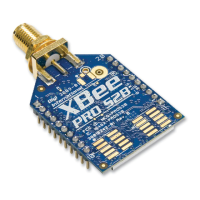Analog and digital IO lines RSSI PWM
XBee/XBee-PRO ZigBee RF Modules User Guide 106
The following table shows an example of the fields in an IS response.
Periodic IO sampling
Periodic sampling allows an XBee/XBee-PRO module to take an IO sample and transmit it to a remote device at a
periodic rate. The periodic sample rate is set by the IR command. If IR is set to 0, periodic sampling is disabled.
For all other values of IR, data will be sampled after IR milliseconds have elapsed and transmitted to a remote
device. The DH and DL commands determine the destination address of the IO samples. DH and DL can be set to
0 to transmit to the coordinator, or to the 64-bit address of the remote device (SH and SL). Only devices running
API firmware can send IO data samples out their UART. Devices running AT firmware will discard received IO data
samples.
A sleeping end device will transmit periodic IO samples at the IR rate until the ST timer expires and the device can
resume sleeping.
Change detection sampling
Modules can be configured to transmit a data sample immediately whenever a monitored digital IO pin changes
state. The IC command is a bitmask that can be used to set which digital IO lines should be monitored for a state
change. If one or more bits in IC is set, an IO sample will be transmitted as soon as a state change is observed in
one of the monitored digital IO lines. Change detection samples are transmitted to the 64-bit address specified by
DH and DL.
RSSI PWM
The XBee module features an RSSI/PWM pin (pin 6) that, if enabled, will adjust the PWM output to indicate the
signal strength of the last received packet. The P0 (P-zero) command is used to enable the RSSI pulse width
modulation (PWM) output on the pin. If P0 is set to 1, the RSSI/PWM pin will output a pulse width modulated
signal where the frequency is adjusted based on the received signal strength of the last packet. Otherwise, for all
other P0 settings, the pin can be used for general purpose IO.
When a data packet is received, if P0 is set to enable the RSSI/PWM feature, the RSSI PWM output is adjusted
based on the RSSI of the last packet. The RSSI/PWM output will be enabled for a time based on the RP command.
Each time an RF packet is received, the RSSI/PWM output is adjusted based on the RSSI of the new packet, and
the RSSI timer is reset. If the RSSI timer expires, the RSSI/PWM pin is driven low. RP is measured in 100 ms units
and defaults to a value of 40 (four seconds).
The RSSI PWM runs at 12 MHz and has 2400 total counts (200 us period).
RSSI (in dBm) is converted to PWM counts using the following equation:
PWM counts = (41 * RSSI_Unsigned) - 5928
Example Sample AT Response
0x01 [1 sample set]
0x0C0C [Digital Inputs: DIO 2, 3, 10, 11 low]
0x03 [Analog Inputs: A/D 0, 1]
0x0408 [Digital input states: DIO 3, 10 high, DIO 2, 11 low]
0x03D0 [Analog input ADIO 0= 0x3D0]
0x0124 [Analog input ADIO 1=0x120]

